#last time we heard colin. was the email from jon
Explore tagged Tumblr posts
Text
this week’s episode. holy shit i am screaming and giggling kicking my feet twirling my hair. it was SO fun. starts with a hilarious dedication. sam is doing more and more paperwork coming out of who knows where, about intrusive questions related to fears and death and blood and existentialism. celia mentions vaguely the institute and a statement (a proper magnus statement!!) about a magnus institute artefact starts playing seemingly on its own with jon’s voice. dnd mentioned. evil dice. statement giver slowly losing their sense of self and enjoying dispensing luck to others in and of itself (fate avatar becoming??). “we both stare at the table and the dice stare back”. i immediately go oh this one was written by jonny wasn’t it. it’s confirmed by the ridiculously gruesome description of gary’s death. [Transcription ends due to interruption. Statement giver declared dead by paramedics at-scene.] cuts to gwen and lena shenanigans. teddy (!!) returns. new info about alice/sam’s background together. layers revealed about alice maybe being jealous of celia?? sam asks alice to go to the magnus ruins with him. “well, we used to be.” [sigh] “when do we leave?”
#SCREAMING#my brain is going crazy rn#thinking back to previous eps. dice related to the dice of the guy in the woods in ep 4???#last time we heard colin. was the email from jon#who gave a name and address- probably gerry’s??#is teddy coming back to the oiar??#gwen what are you doing??#tmagp#the magnus protocol#tmagp spoilers#char listens to tma#tmagp thoughts
21 notes
·
View notes
Text
TMAGP Theory Board (Episode 8-9)
Hi guys sorry about the missed week of theory crafting my schoolwork has been extra demanding and I haven't been able to get around to updating the board until now so here's the updated board


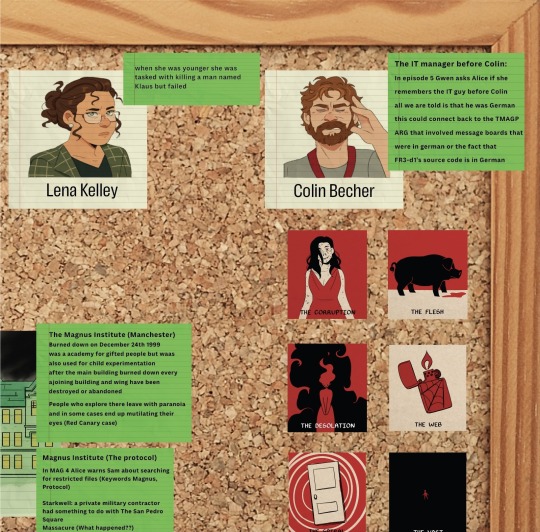
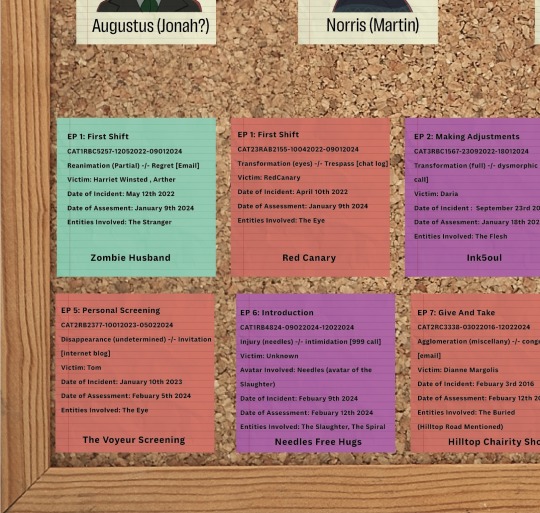

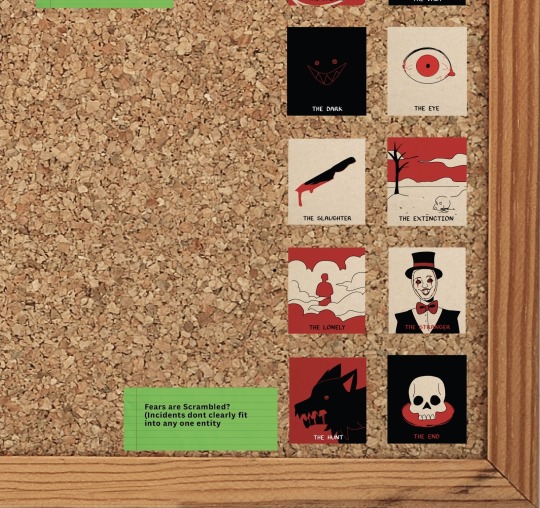
Episode 8 especially was insane so I'm gonna break the episode breakdown into two sections.
What Happened in Episode 8: Running On Empty

New Norris Statement! it's been a while since we heard from our buddy and he did not disappoint. though there's not much to say story-wise this was just a cool incident report I loved the way they described the Lonely as a constantly hungry entity. I also noticed that the pattern of Norris's statements having to do with lost love continues to be true. it's much more subtle than his previous two incidents but the statement giver does mention losing his wife because of divorce. which I believe still follows the pattern I've theorized is taking place.
Something up with Alice. She seems more depressed and serious than she usually is in this episode. (through episode 9 I think I know why but I'll get to that later. I don't believe she is completely in the dark like some of the newer employees and after hearing about Gwen's promotion she is getting suspicious. we have yet to know if Alice knows what's happening. but her behavior in this episode might give us a hint about how naive she actually is.
Colin is Absent. After his freakout in EP 7, Colin is MIA. according to Lena, he's on a mental health break but I would not be surprised if that is a lie.
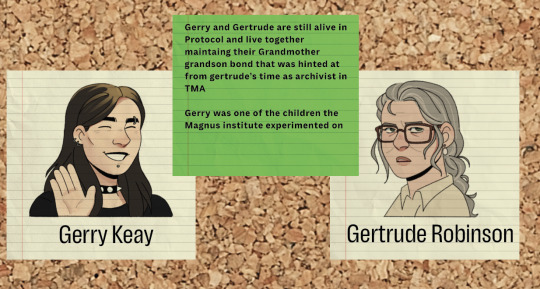
Gerry and Gertrude are Alive!! Probably the most exciting development in this episode was meeting an alive Gerry Keay and Gertrude Robison. Sam is on the hunt for info about the Magnus Institute after the emails Jon has been sending him and he and Celia end up meeting Gerry who in this universe is considerably more happy and lives with Gertrude. I'm interested to know what role Gertrude plays in this universe is she at all connected to the Institute? I definitely think something is up with her because of the way she tries to deflect Sam's question to Gerry.
Celia Lore. after the meeting with Gerry leads to a dead end for Sam, Celia asks him to help her with her mystery. "I'm trying to look into... Weird physics stuff: time travel, other dimensions, teleportation" More proof for this Celia being from from Archives. why else would she be looking into other dimensions specifically if she wasn't trying to figure out what happened at the Panopticon. (Remember as far as we know Celia before the change in Archives was just a normal person she had no connection to the entities or the Institute.) when Sam asks, she says it's for her friend's podcast but I think she's lying. or not telling the full truth.
Georgie Barker Perhaps? speaking of the friend. our last reveal of the episode is Georgie in protocol. I don't think she is from Archives because Georgie appears after Jons's sacrifice in MAG 200.
And thats it for episode 8 so im gonna move on to Episode 9
What happened in Episode 9: Rolling With It
Sam is back to filling out onboarding paperwork but the questions on it are strange. asking about past traumas, how many dead things you've seen recently, and the infamous question why? similar types of questions that appear in TMA job interviews.

A Magnus Statement!?! After Celia tells Sam she can't find anything at the Magnus Institute Sam considers cutting his losses and letting it go. But then Chester without any prompting begins reading a Magnus statement incident to Sam. I still believe Chester is Jon and he acts as a mentor to Sam trying to keep him safe by providing him with bits of the answers he's looking for. (this way Sam won't be in danger of looking for answers elsewhere and maybe he won't be targeted by this unknown force that had killed RedCanary and driven Colin to extreme paranoia.) the statement reveals that the institute collected and stored artifacts much like the Institute in Archives.
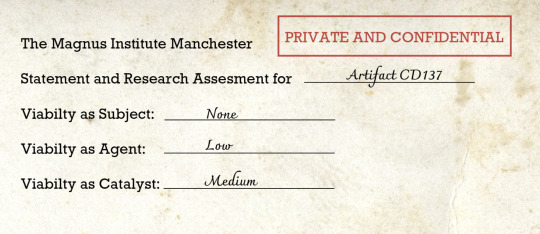
What's the deal with the Institute? the statement Chester shares this episode is pretty standard Magnus stuff, magic fear dice is just another Thursday for TMAG enjoyers. but what I found most interesting was the pre-statement info. What does this viability survey mean? viable for what? I and my roommate have a kind of joke theory that the Institute in this universe is a hub for training and creating new avatars but now I'm starting to think this might actually be the case. I think they are looking for people who have the potential to become avatars as subjects. for the agents, they might be employing avatars to work for the institute and the catalyst has to be finding an avatar that can complete the ritual and bring the Change. The unknown statement giver in this episode can't be a subject because they are already claimed by a power from the dice (still unsure what power it is ) they have low potential to become an agent because based on the end of the statement they now want nothing to do with the dice stepping away from their identity as a fear avatar and then dying. and for some reason, the institute must see some potential that this individual can serve as a catalyst for the ritual. I'm hopeful we'll get another avatar statement and maybe we can revisit this Viability survey again
Gwen's First assignment. Gwen gets her first Liason assignment and it has brought up a major player from the protocol ARG. Mr Bonzo is this weird mascot character that showed up multiple times in the ARG that was launched back in the fall of 2023. Gwen is tasked with delivering an envelope with a name and address to Nigel Dickerson someone who according to Gwen is known for Mr. Bonzo. Basically, I have no idea where this is going but I definitely think it must be important.

Poor Alice. Alice meets with Teddy to catch up. Nothing story significant happens here but we do learn that maybe Alice still harbors some romantic feelings towards Sam.
The Ruins. After her conversation with Teddy Alice is approached by Sam with a request. He wants to go to the old Magnus Institute ruins and wants Alice to come with him. This is definitely a bad idea but she agrees and that's where we leave off
and thats it for now. The story is getting so good and I'm already attached to all the characters so im terrified to see what Sam and alice dig up at the ruins (Sam clearly didn't heed the warning of the RedCanary)
#augustus tmagp#chester tmagp#gwendolyn bouchard#jonathan sims#lena kelley#martin blackwood#norris tmagp#the magnus protocol#tmagp#tmagp theory#colin becher#gwen bouchard#alice dyer#samama khalid#sam khalid#fanart#the magnus protocol spoilers#celia ripley#the magnus institute#the magnus pod#gertrude robinson#gerry keay
120 notes
·
View notes
Text
TMAGP Episodes 7 & 8 Reactions

That was totally my face during both episodes, I swear.
Spoilers below!
Okay, I'm freaking out on a cellular level, it feels like.
Episode 6 had the introduction of new OIAR employee, Celia Ripley, who is voiced by Lowri Ann Davies. Those of us from the TMA fandom recognize her as the voice of Lynne Hammond who later became Celia because her name was taken from her after the Change. There have been speculations on whether she is playing the same Celia (even though this is a separate universe) or if this is just a little wink from Jonny and Alex behind the scenes. But then came the next 2 episodes.
The sheer amount of lore that was dropped in these 2 episodes has the fandom REELING. So, let's get into what we've heard!!
EPISODE 7: Right off the bat, Celia not only references that the dated computer system is basically better than "wrestling with tape recorders and manila folders." This feels like a TARGETED MISSILE at the TMA fandom. But right after that, she asks if any of the spoken cases have anything in common, and if there's a way to search the cases that have common threads, like, "Oh I don’t know. Every case about being buried alive or meat or… whatever." And if that wasn't enough, she recognizes the voice that Alice calls Chester (AKA, John!).
Those statements alone have me thinking with 99.99999999% certainty that this is the SAME Celia from TMA (or at least, she's tapped into her memories in some way).
Apart from Celia, we have Hilltop being referenced in a case, which could very well mean that it's a similar situation from TMA. Very possibly a rift in space-time or whatever. Some nexus of power or something.
Then Sam received a supposedly internal email from someone called "John" that contained an address and a name. Does this mean that John is truly trapped in the computer system like we've all been theorizing? Is this his attempt at making contact and warning Sam not to follow in his footsteps? AGH!
And then we have poor Colin, driven mad by whatever's corrupting the code he's been trying to maintain, taped over his webcam, and full on refusing any electronics to enter his office (that weren't already there, and he must have clearly tampered with them so they cannot spy on him). He even attacks Sam when he pulls out his phone. That man has a lifetime subscription to Paranoia Plus, if you ask me, poor thing.
Lastly, we get confirmation that Lena at least tried to kill Klaus, but may not have succeeded, and Gwen's blackmail of her puts her in a new role of "External Liaison," whatever that may be. (Oh boy, oh boy.)
And if that wasn't enough, we have today's episode....
EPISODE 8: No preamble on this one, just straight into a case. And man, are we having fun with the whole liminal horror plus Stranger vibes in this one! But the GOOD SH*T comes after the case ends.
Poor Colin's been put on Mental Health Leave, so I'm really hoping that wasn't the last we'll 'see' of him. And the banter between Gwen and Alice has much more of an edge now that Gwen's been promoted. But!!!
Sam and Celia went off together after they ended their shifts early (ooooh), and who did they meet?
GERRY EFFING KEAY AND HIS 'GEE-GEE' GERTRUDE!!!!
And I checked, yes, they are 100% voiced by their TMA counterparts, Jon Gracey and Sue Sims (Jonny's mom).
Gertrude calls Gerry her grandson (though I'm curious if this means Gerry's actual mother is dead here too, and when Gertrude stepped in as a surrogate, or if she's actually his grandmother).
When Sam and Celia ask about the Magnus Institute, they both kind of go quiet, like they don't know what they're allowed to say or if they can trust these strangers who randomly showed up to their house. Sam reveals that he was part of their "gifted kids" program (hello, ARG info!) and saw Gerry was also listed and wanted to "swap stories." Gertrude seems to want to push them away, all protective, but Gerry just says he doesn't remember much.
Did Gertrude blow up the Magnus Institute in this universe and adopt Gerry after she found him there?!?
And finally, after Gertrude kind of rushes them out, Celia makes a deal with Sam. They agree to keep track of anything that falls under each other's mystery interests. Because she's "doing a favor for Georgie" (HFGJHFD!), she needs to look into "Weird physics stuff: time travel, other dimensions, teleportation, all that good stuff."
Was Celia sent here from the TMA dimension to do recon?!?
Anyway, there's so much more to dive into, but those are the things that are currently making my brain buzz. How has your Thursday been?
28 notes
·
View notes
Text
My thoughts about TMAGP 7 before reading anyone else's:
Oh my god we got a lot of stuff today
Celia recognizes Chester's voice which could imply a few things: One, Jon is alive in this universe and she met/knew/heard of him. Two, Jonny Sims is playing an entirely different character with whom Celia has met/known/heard. OR three, Celia has previous experience with the fears. All three are equally likely in my opinion, IF it weren't for the next piece of information.
Sam got an email from someone named John. (I checked the spelling on the official transcript and that is how it is spelled). The email was internal. I'm not going to jump to conclusions about this because of how this is spelt and because Jonny is known to reuse names. (See Jared and Gerard, and Michael). However, if I were a writer, I wouldn't mind using common names for smaller characters that may or may not show up again, but would mind severely if a major character shared a name with a minor character. Jury's still out on this for me.
Colin doesn't allow external devices into his workspace. I didn't think about it much in earlier episodes, but I think it is notable that we only hear him occasionally and never from his own devices. Sam brings in external devices, or he's out and about, in a place where devices can hear him. He could be worried that they interfere with his work, but Sam had described him as otherwise paranoid and worrying about interference seems to be something not worth fighting about. This leads me to believe Colin knows something is going on.
The mention of hilltop road is interesting. I'm aware that Hilltop road is a road an therefore could have multiple addresses, but since it was such a significant part of MAG, I think it is worth noting what happened there. To me, it feels like a bunch of avatars, or a cult, similar to that of the Lifeless Flame attempted to bring a bunch of items that could possibly be fear-adjacent (like Leitner books) into a place of power. That's pure speculation, however.
Lena has attempted to murder at least two different people, and they both suggest "disappearing again". I have no idea what this could mean, but it feels relevant to me. I'm keeping this in mind for future refrence.
Lena makes mention of "real work" which leads me to wonder what everyone is doing there. People have speculated that the OIAR is feeding the eye in the same way the Magnus Institute was and I think I agree with that. However, Magnus' goal with the institute was to start the eyepocalypse. Is this what Lena is doing? If so, how? Is she doing it the same way Magnus was, by taking a already fear-touched person and using them as their avatar? If that's the case, what is the point of the files that they are reading?
Gwen's family is rich. I don't know if it was mentioned in MAG that the Bouchards had money, but I think it's more relevant here. It also explains her entitlement and the fact that she watched two attempted (and one successful?) murders and decided that this was the line of employment she wanted to continue. I'm biased because I have a history with the name, but we're only seven episodes in and I already don't like her.
Last and very least, Alice thinks Norris's voice (possibly aka Martin's voice) is whiny.
This was a way longer post than I meant to write, but I'm interested in seeing where the fan discussion goes. This was such a plot-heavy episode that I'm still taking time to digest it. I'm also really interested in seeing how my theories and thoughts evolve.
#jonathan sims#tmagp theory#tmagp spoilers#alice dyer#celia ripley#colin becher#gwen bouchard#lena kelley#i'm going insane#this is so much for one episode#especially since i havent written about any of the others like this#maybe i will from now on#TMAGP#TMAGP 7
35 notes
·
View notes
Text
Do Seatback Screens on Planes Have a Future? — Skift Airline Innovation Report
Delta Air Lines is one of the few carriers investing in both in-seat entertainment and fast Wi-Fi. Pictured is Delta's new premium economy for long-haul flights. Delta Air Lines
Skift Take: Seatback entertainment screens are so 2002. Airlines should remove them and focus on what their highest-value travelers actually want — fast, reliable Wi-Fi. Passengers who care about quality entertainment can load up their own devices with stuff they actually want to watch. Or they can stream from a server on the plane.
— Brian Sumers
The Skift Airline Innovation Report is our weekly newsletter focused on the business of airline innovation. We will look closely at the technological, financial, and design trends at airlines and airports that are driving the next-gen aviation industry.
We provide insights on need-to-know developments in passenger experience, ancillary services, revenue management, loyalty, technology, marketing, airport innovation, the competitive landscape, startups, and changing passenger behavior. The newsletter, sent on Wednesdays, is written and curated by me. We will look closely at the technological, financial, and design trends at airlines and airports that are driving the next-generation aviation industry. You can find previous issues of the newsletter here.
What’s the point of embedded in-flight entertainment systems?
They’re heavy. They’re not as sophisticated as consumer electronics. They break more often than airlines would like. They rarely have enough content to satisfy all passenger segments. And, because of the lead time required to produce, certify and install the systems, they’re often technologically obsolete before their first flight.
Yet they persist. Almost every full-service airline installs in-seat screens on all long-haul planes. Some, such as Singapore Airlines and Emirates and even Delta Air Lines, use screens as a competitive advantage, loading them with high-definition content people want to watch. But for many others, entertainment seems like an afterthought — something airlines feel they must provide, but don’t put much effort into.
A few airlines have given up. Mostly, these are discounters, including Norwegian Air on its Boeing 737 Max, and Wow Air. But other airlines have begun to take similar approaches for midrange flights. Qantas doesn’t have screens on some A330s, instead giving iPads for longer domestic routes. And United Airlines didn’t put embedded systems into its revamped high-density Boeing 777s. Mostly, they fly shorter domestic routes, but they’re also used on Guam-Honolulu, a seven-hour flight. (We’ve heard rumors these cost-friendly United aircraft may fly to Europe soon.)
I don’t understand why screens are so sacrosanct. In so many ways, from flyer programs to lounges to segmented onboard products, airlines cater to their highest-value customers. But business travelers rarely choose airlines for in-flight entertainment. If they want entertainment, they can load their tablets with what they want to see — not what the airline chooses. If customers pick an airline based on screens, they’re probably leisure customers of lower value to the airline.
What do business travelers want? Well, I have recently become one — Skift sends me on trips often to learn about airline trends — and I think I am beginning to understand what road warriors crave. We need reliable Wi-Fi. It doesn’t need to be super fast, but must be good enough for the basics. In 2017, I can’t lose a day of productivity because an airline has prioritized entertainment over Wi-Fi. When my CEO needs me, he expects a response.
This week, we published an interview with Jon Norris, senior director for corporate sales and marketing at Panasonic Avionics. I tried to ask (gently) whether there’s a future for embedded systems. Norris is a salesman, so of course he sees a bright future. But I’m not so optimistic. Remember, embedded in-flight entertainment has only been around for a couple of decades — before that we watched movies on overhead screens. Embedded systems may not last forever.
What do you think? Does embedded in-flight entertainment have a long-term future? Email me your thoughts to [email protected] or on Twitter. I’m @briansumers. Or, if you’re feeling adventurous, follow me on Instagram, and send me a note there. I’m @bsumers.
— Brian Sumers, Airline Business Reporter
What’s coming up
I’ve been working on a longer story about why many airlines have fallen behind with their e-commerce strategies. My favorite quote comes from Peter Glade, commericial director for Sun Express, a European leisure airline owned by Lufthansa and Turkish Airlines. He told me airlines must improve their approaches, or another company — perhaps Google or Amazon, or even another firm that doesn’t exist yet — will handle retailing for them.
In short, he said, an airline must decide whether it wants to be Uber, or the Uber driver.
“Our decision as an airline shall be, ‘Am I the one that is transporting the passenger from A to B, or am I the one that is managing the problem that the customer has to an extent so that the customer is happy and wants to fly with me again,'” Glade told me. “Do I want to be a transportation organization or a problem solver?”
What do you think of his analogy?
Most Interesting Stories of the Week
Interview: Why In-Flight Entertainment Screens May Persist on Long-Haul Routes: As I mentioned, Panasonic’s Jon Norris is the latest subject in my new interview series called Airline Insiders, in which I introduce readers to executives with interesting jobs. My next two interviews are with the vice president for innovation at Gate Group, and the director of planning at Allegiant Air. Do you know of someone I might interview next? The only requirement: All subjects must have a playful sense of humor. Email me if you want in.
J.D. Power Finds U.S. Frequent Flyers Prefer JetBlue’s Loyalty Program: J.D. Power ranks everything, including cars, electronics and banks. A few years ago, it started ranking airline loyalty programs, and this year, it claims it interviewed 3,400 Americans to determine their favorites. The winner was JetBlue — a surprise to those of us who cover loyalty. JetBlue offers an easy-to-understand program, but it’s far from the most generous. “JetBlue has a regional and simple program but doesn’t offer much of an opportunity beyond simple rebates,” Gary Leff, of ViewFromTheWing, told me. J.D. Power didn’t share its methodology, so we don’t know what questions the company asked.
Surf Air Positions Itself for the Post-Brexit Commuter: California-based all-you-can-fly airline Surf Air often reinvents itself. Management changes often, as does the airline’s route network. Yes, Surf Air has consistently flown California short-haul flights since it started in 2013, but the company has been constantly searching for the next-best-thing. Surf Air recently expanded to Europe, where it expects its subscription business will thrive, with full members paying more than $4,000 per month to fly as much as they want from private terminals in London, Cannes, Ibiza and Zurich. Colin Nagy’s Skift’s business travel columnist, thinks it can thrive. I’m less sure.
VietJet Mulls U.S. Route With Widebody Planes: Low-cost airline VietJet wants to acquire big jets and fly from Vietnam to California as soon as 2019, according to a Bloomberg story posted on Skift. We commend VietJet for disrupting the Southeast Asia short-haul market, but long-haul operations are another story. Yes, lots of Vietnamese-Americans live in Southern California, but this cannot be a good idea. Brendan Sobie, an analyst with CAPA – Centre for Aviation, put it better. “The prospect of making money on this route is bleak,” he said.
Emirates Upgrades First-Class Suites While Competitors Downplay Such Luxury: In September, I interviewed Emirates President Tim Clark in London, and he promised the airline’s new suites would be “game changers.” It’s an overused phrase, but perhaps it was apt. Emirates introduced its new first class for the Boeing 777-300ER, and Bloomberg reports it has all the over-the-top luxury you’d expect — including technology that creates fake window views for passengers in middle seats. Oddly, Emirates isn’t in a rush to reconfigure most of the fleet, and some aircraft may never get the new suite. Travelers may book the 777-300ER thinking they’ll get it, only to be disappointed.
Investment Group Plans to Bring World Airways Back From the Dead: Apparently Ed Wegel knows only one formula — resurrecting defunct airlines using old logos and newer planes. Several years ago, he brought back Eastern Air Lines, and many reporters — including me, for Conde Nast Traveler — wrote light-hearted stories about airline nostalgia. But the new Eastern didn’t grow as Wegel promised, and earlier this year some of its assets were purchased by charter operator Swift Air. Wegel has a new project — recreating World Airways. He told Bloomberg his investment group wants to acquire 10 Boeing 787s. Then again, when he led Eastern, the airline ordered at least 20 Mitsubishi MRJ90s, an aircraft the airline nicknamed, the “Eastern Whisperjet.”
Other Stories of note
Emirates Looks Past Turmoil With Huge Boeing Deal: Emirates has historically bought the biggest jets from Airbus and Boeing, but its strategy is changing slightly, Jon Ostrower wrote for CNN. The airline announced a big order this week for Boeing 787-10s. It’s still a big plane, but it’s no A380. “It gives us far more in our arsenal to deal with the type segmentation of demand that we’re looking at in the next decade,” Emirates CEO Tim Clark told CNN.
More Airlines Suspend Use of Onboard Caterer After Listeria Detection: What’s happening at Gate Gourmet’s kitchen at LAX? At least three airlines have temporarily dropped the caterer, including American Airlines and Delta Air Lines. They say they’re concerned Listeria has been found on some surfaces. I spoke late last week with a Gate Gourmet executive, and she said it’s not a big deal, and the kitchen is safe. The airlines say otherwise. Leslie Josephs of CNBC has the story.
On Airplanes, Considering Fighting Cameras With Cameras: Should airline employees wear body cameras to protect against passengers who might make complaints? That seems a bit extreme, but The New York Times reported this week some airline employees want cameras. One of the world’s largest carriers, American Airlines, has no plans to use them, spokesman Ross Feinstein said, but it is concerned some passengers do not behave with proper decorum. “People are putting their phone up, saying, ‘You better book me on the next flight,’” he told the Times. “They’re trained to intimidate our crew members using their phone.”
Subscribe
The Skift Airline Innovation Report is curated by Skift Airline Business Reporter Brian Sumers [[email protected]]. The newsletter is emailed every Wednesday.
Subscribe to the Skift Airline Innovation Report
0 notes
Text
Do Seatback Screens on Planes Have a Future? — Skift Airline Innovation Report
Delta Air Lines is one of the few carriers investing in both in-seat entertainment and fast Wi-Fi. Pictured is Delta's new premium economy for long-haul flights. Delta Air Lines
Skift Take: Seatback entertainment screens are so 2002. Airlines should remove them and focus on what their highest-value travelers actually want — fast, reliable Wi-Fi. Passengers who care about quality entertainment can load up their own devices with stuff they actually want to watch. Or they can stream from a server on the plane.
— Brian Sumers
The Skift Airline Innovation Report is our weekly newsletter focused on the business of airline innovation. We will look closely at the technological, financial, and design trends at airlines and airports that are driving the next-gen aviation industry.
We provide insights on need-to-know developments in passenger experience, ancillary services, revenue management, loyalty, technology, marketing, airport innovation, the competitive landscape, startups, and changing passenger behavior. The newsletter, sent on Wednesdays, is written and curated by me. We will look closely at the technological, financial, and design trends at airlines and airports that are driving the next-generation aviation industry. You can find previous issues of the newsletter here.
What’s the point of embedded in-flight entertainment systems?
They’re heavy. They’re not as sophisticated as consumer electronics. They break more often than airlines would like. They rarely have enough content to satisfy all passenger segments. And, because of the lead time required to produce, certify and install the systems, they’re often technologically obsolete before their first flight.
Yet they persist. Almost every full-service airline installs in-seat screens on all long-haul planes. Some, such as Singapore Airlines and Emirates and even Delta Air Lines, use screens as a competitive advantage, loading them with high-definition content people want to watch. But for many others, entertainment seems like an afterthought — something airlines feel they must provide, but don’t put much effort into.
A few airlines have given up. Mostly, these are discounters, including Norwegian Air on its Boeing 737 Max, and Wow Air. But other airlines have begun to take similar approaches for midrange flights. Qantas doesn’t have screens on some A330s, instead giving iPads for longer domestic routes. And United Airlines didn’t put embedded systems into its revamped high-density Boeing 777s. Mostly, they fly shorter domestic routes, but they’re also used on Guam-Honolulu, a seven-hour flight. (We’ve heard rumors these cost-friendly United aircraft may fly to Europe soon.)
I don’t understand why screens are so sacrosanct. In so many ways, from flyer programs to lounges to segmented onboard products, airlines cater to their highest-value customers. But business travelers rarely choose airlines for in-flight entertainment. If they want entertainment, they can load their tablets with what they want to see — not what the airline chooses. If customers pick an airline based on screens, they’re probably leisure customers of lower value to the airline.
What do business travelers want? Well, I have recently become one — Skift sends me on trips often to learn about airline trends — and I think I am beginning to understand what road warriors crave. We need reliable Wi-Fi. It doesn’t need to be super fast, but must be good enough for the basics. In 2017, I can’t lose a day of productivity because an airline has prioritized entertainment over Wi-Fi. When my CEO needs me, he expects a response.
This week, we published an interview with Jon Norris, senior director for corporate sales and marketing at Panasonic Avionics. I tried to ask (gently) whether there’s a future for embedded systems. Norris is a salesman, so of course he sees a bright future. But I’m not so optimistic. Remember, embedded in-flight entertainment has only been around for a couple of decades — before that we watched movies on overhead screens. Embedded systems may not last forever.
What do you think? Does embedded in-flight entertainment have a long-term future? Email me your thoughts to [email protected] or on Twitter. I’m @briansumers. Or, if you’re feeling adventurous, follow me on Instagram, and send me a note there. I’m @bsumers.
— Brian Sumers, Airline Business Reporter
What’s coming up
I’ve been working on a longer story about why many airlines have fallen behind with their e-commerce strategies. My favorite quote comes from Peter Glade, commericial director for Sun Express, a European leisure airline owned by Lufthansa and Turkish Airlines. He told me airlines must improve their approaches, or another company — perhaps Google or Amazon, or even another firm that doesn’t exist yet — will handle retailing for them.
In short, he said, an airline must decide whether it wants to be Uber, or the Uber driver.
“Our decision as an airline shall be, ‘Am I the one that is transporting the passenger from A to B, or am I the one that is managing the problem that the customer has to an extent so that the customer is happy and wants to fly with me again,'” Glade told me. “Do I want to be a transportation organization or a problem solver?”
What do you think of his analogy?
Most Interesting Stories of the Week
Interview: Why In-Flight Entertainment Screens May Persist on Long-Haul Routes: As I mentioned, Panasonic’s Jon Norris is the latest subject in my new interview series called Airline Insiders, in which I introduce readers to executives with interesting jobs. My next two interviews are with the vice president for innovation at Gate Group, and the director of planning at Allegiant Air. Do you know of someone I might interview next? The only requirement: All subjects must have a playful sense of humor. Email me if you want in.
J.D. Power Finds U.S. Frequent Flyers Prefer JetBlue’s Loyalty Program: J.D. Power ranks everything, including cars, electronics and banks. A few years ago, it started ranking airline loyalty programs, and this year, it claims it interviewed 3,400 Americans to determine their favorites. The winner was JetBlue — a surprise to those of us who cover loyalty. JetBlue offers an easy-to-understand program, but it’s far from the most generous. “JetBlue has a regional and simple program but doesn’t offer much of an opportunity beyond simple rebates,” Gary Leff, of ViewFromTheWing, told me. J.D. Power didn’t share its methodology, so we don’t know what questions the company asked.
Surf Air Positions Itself for the Post-Brexit Commuter: California-based all-you-can-fly airline Surf Air often reinvents itself. Management changes often, as does the airline’s route network. Yes, Surf Air has consistently flown California short-haul flights since it started in 2013, but the company has been constantly searching for the next-best-thing. Surf Air recently expanded to Europe, where it expects its subscription business will thrive, with full members paying more than $4,000 per month to fly as much as they want from private terminals in London, Cannes, Ibiza and Zurich. Colin Nagy’s Skift’s business travel columnist, thinks it can thrive. I’m less sure.
VietJet Mulls U.S. Route With Widebody Planes: Low-cost airline VietJet wants to acquire big jets and fly from Vietnam to California as soon as 2019, according to a Bloomberg story posted on Skift. We commend VietJet for disrupting the Southeast Asia short-haul market, but long-haul operations are another story. Yes, lots of Vietnamese-Americans live in Southern California, but this cannot be a good idea. Brendan Sobie, an analyst with CAPA – Centre for Aviation, put it better. “The prospect of making money on this route is bleak,” he said.
Emirates Upgrades First-Class Suites While Competitors Downplay Such Luxury: In September, I interviewed Emirates President Tim Clark in London, and he promised the airline’s new suites would be “game changers.” It’s an overused phrase, but perhaps it was apt. Emirates introduced its new first class for the Boeing 777-300ER, and Bloomberg reports it has all the over-the-top luxury you’d expect — including technology that creates fake window views for passengers in middle seats. Oddly, Emirates isn’t in a rush to reconfigure most of the fleet, and some aircraft may never get the new suite. Travelers may book the 777-300ER thinking they’ll get it, only to be disappointed.
Investment Group Plans to Bring World Airways Back From the Dead: Apparently Ed Wegel knows only one formula — resurrecting defunct airlines using old logos and newer planes. Several years ago, he brought back Eastern Air Lines, and many reporters — including me, for Conde Nast Traveler — wrote light-hearted stories about airline nostalgia. But the new Eastern didn’t grow as Wegel promised, and earlier this year some of its assets were purchased by charter operator Swift Air. Wegel has a new project — recreating World Airways. He told Bloomberg his investment group wants to acquire 10 Boeing 787s. Then again, when he led Eastern, the airline ordered at least 20 Mitsubishi MRJ90s, an aircraft the airline nicknamed, the “Eastern Whisperjet.”
Other Stories of note
Emirates Looks Past Turmoil With Huge Boeing Deal: Emirates has historically bought the biggest jets from Airbus and Boeing, but its strategy is changing slightly, Jon Ostrower wrote for CNN. The airline announced a big order this week for Boeing 787-10s. It’s still a big plane, but it’s no A380. “It gives us far more in our arsenal to deal with the type segmentation of demand that we’re looking at in the next decade,” Emirates CEO Tim Clark told CNN.
More Airlines Suspend Use of Onboard Caterer After Listeria Detection: What’s happening at Gate Gourmet’s kitchen at LAX? At least three airlines have temporarily dropped the caterer, including American Airlines and Delta Air Lines. They say they’re concerned Listeria has been found on some surfaces. I spoke late last week with a Gate Gourmet executive, and she said it’s not a big deal, and the kitchen is safe. The airlines say otherwise. Leslie Josephs of CNBC has the story.
On Airplanes, Considering Fighting Cameras With Cameras: Should airline employees wear body cameras to protect against passengers who might make complaints? That seems a bit extreme, but The New York Times reported this week some airline employees want cameras. One of the world’s largest carriers, American Airlines, has no plans to use them, spokesman Ross Feinstein said, but it is concerned some passengers do not behave with proper decorum. “People are putting their phone up, saying, ‘You better book me on the next flight,’” he told the Times. “They’re trained to intimidate our crew members using their phone.”
Subscribe
The Skift Airline Innovation Report is curated by Skift Airline Business Reporter Brian Sumers [[email protected]]. The newsletter is emailed every Wednesday.
Subscribe to the Skift Airline Innovation Report
0 notes